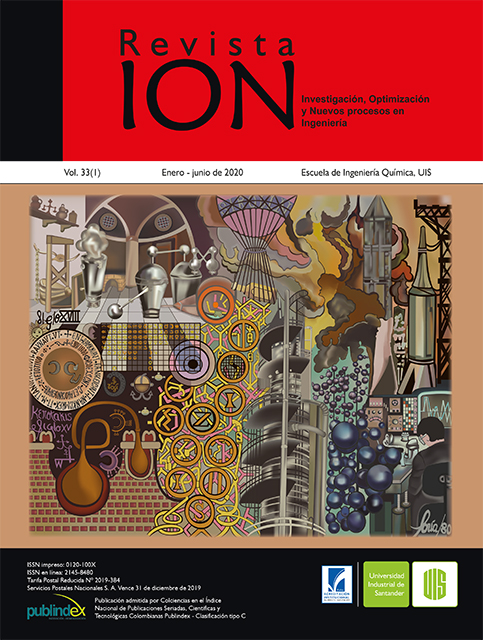2k factorial design to optimize the synthesis of silver nanoparticles for application in biomaterials
Published 2020-06-30
Keywords
- Silver Nanoparticles,
- Biomaterial,
- Antimicrobial,
- Factorial Design,
- Optimization
How to Cite
Abstract
Silver nanoparticles (AgNPs) are an alternative to the use of antibiotics due to their antimicrobial and bactericidal properties. To produce this required functionality, they must have adequate geometry and size. To observe which factors influence these properties, a factorial design 24 was performed varying the following production conditions: synthesis temperature, concentration of silver nitrate (precursor agent), percentage of trisodium citrate (reducing agent) and polyvinyl alcohol (PVA) (dispersing agent). The obtained nanoparticles were evaluated using UV-Vis, TEM and DLS. From the results, an analysis of variance (ANOVA) was performed using RStudio. Then, STATGRAPHIC centurion XVII was used to find the synthesis parameter values that allowed to produce nanoparticles with 20 nm diameter. As a result, AgNPs with sizes between 6 and 100 nm were obtained. The results demonstrated that the percentage of PVA does not influence the synthesis, while all other factors such as temperature, the percentage of trisodium citrate, the concentration of silver nitrate and the interaction between them, influence the final particle size. For the optimization of AgNPs production, a size of 20 nm was chosen since a greater antimicrobial capacity is reported using this diameter. It was possible to conclude that to achieve the appropriate shape and size, the following conditions must be met: temperature of 90 °C, concentration of silver nitrate at 0.13 M and a concentration of trisodium citrate of 10 %.
Downloads
References
[2] Seil JT, Webster TJ. Antimicrobial applications of nanotechnology: methods and literature. Int. J. Nanomed. 2012;7:2767–81.
[3] Guzman M, Dille J, Godet S. Synthesis and antibacterial activity of silver nanoparticles against gram-positive and gram-negative bacteria. Nanomedicine. 2012;8(1):37-45.
[4] Zhang JP, Chen P, Sun CH, Hu XJ. Sonochemical synthesis of colloidal silver catalysts for reduction of complexing silver in DTR system. Applied Appl. Catal., A. 2004;266(1):49-54.
[5] Patel K, Kapoor S, Dave DP, Mukherjee T. Synthesis of nanosized silver colloids by microwave dielectric heating. J. Chem. Sci. 2005;117(1):53-60.
[6] Pal S, Tak YK, Song JM. Does the antibacterial activity of silver nanoparticles depend on the shape of the nanoparticle? A study of the gram-negative bacterium Escherichia coli. Appl. Environ. Microbiol. 2007;73(6):1712–20.
[7] Benedí J. Apósitos. Farmacia Profesional. 2006;20(6):52-6.
[8] Amarís MR, Rojas JB, Batista AG, Chaparro CG, García JP, Rodríguez LV. Factores asociados al pie diabético en pacientes ambulatorios. Centro de Diabetes Cardiovascular del Caribe. Barranquilla (Colombia). Salud Uninorte. 2012;28(1):65-74.
[9] Zhao L, Wang H, Huo K, Cui L, Zhang W, Ni H, Zhang Y, Wu Z, Chu PK. Antibacterial nano-structured titania coating incorporated with silver nanoparticles. Biomaterials. 2011;32(24):5706-16.
[10] Farzin L, Sadjadi S, Shamsipur M, Sheibani S, hasan Mousazadeh M. Employing AgNPs doped amidoxime-modified polyacrylonitrile (PAN-oxime) nanofibers for target induced strand displacement-based electrochemical aptasensing of CA125 in ovarian cancer patients. Mater. Sci. Eng., C. 2019;97:679-87.
[11] Dadashpour M, Firouzi-Amandi A, Pourhassan-Moghaddam M, Maleki MJ, Soozangar N, Jeddi F, Pilehvar-Soltanahmadi Y. Biomimetic synthesis of silver nanoparticles using Matricaria chamomilla extract and their potential anticancer activity against human lung cancer cells. Mater. Sci. Eng., C. 2018;92:902-12.
[12] Mogoşanu GD, Grumezescu AM. Natural and synthetic polymers for wounds and burns dressing. Int. J. Pharm. 2014;463(2):127-36.
[13] Hebeish A, El-Rafie MH, El-Sheikh MA, Seleem AA, El-Naggar ME. Antimicrobial wound dressing and anti-inflammatory efficacy of silver nanoparticles. Int. J. Biol. Macromol. 2014;65:509-15.
[14] Ding L, Shan X, Zhao X, Zha H, Chen X, Wang J, Yu G. Spongy bilayer dressing composed of chitosan–Ag nanoparticles and chitosan–Bletilla striata polysaccharide for wound healing applications. Carbohydr. Polym. 2017;157:1538-47.
[15] Levi-Polyachenko N, Jacob R, Day C, Kuthirummal N. Chitosan wound dressing with hexagonal silver nanoparticles for hyperthermia and enhanced delivery of small molecules. Colloids Surf., B. 2016;142:315-24.
[16] Bozaci E, Akar E, Ozdogan E, Demir A, Altinisik A, Seki Y. Application of carboxymethylcellulose hydrogel based silver nanocomposites on cotton fabrics for antibacterial property. Carbohydr. Polym. 2015;134:128-35.
[17] Rubina MS, Kamitov EE, Zubavichus YV, Peters GS, Naumkin AV, Suzer S, Vasil’kov AY. Collagen-chitosan scaffold modified with Au and Ag nanoparticles: Synthesis and structure. Appl. Surf. Sci. 2016;366: 365-71.
[18] Carmona MER, da Silva MAP, Leite SGF. Biosorption of chromium using factorial experimental design. Process Biochem. 2005;40(2):779-88.
[19] Enis IY, Sezgin H, Sadikoglu TG. Full factorial experimental design for mechanical properties of electrospun vascular grafts. J. Ind. Text. 2018;47(6):1378-91.
[20] Montgomery DC. Design and analysis of experiments. United States: John wiley & sons; 2017.
[21] Gallo Ramirez JP, Ossa Orozco CP. Fabricación y caracterización de nanopartículas de plata con potencial uso en el tratamiento del cáncer de piel. Ing. Desarro. 2019;37(1):88-104.
[22] Ananda AP, Manukumar HM, Krishnamurthy NB, Nagendra BS, Savitha KR. Assessment of antibacterial efficacy of a biocompatible nanoparticle PC@ AgNPs against Staphylococcus aureus. Microb. Pathog. 2019;126:27-39.
[23] Ahila NK, Ramkumar VS, Prakash S, Manikandan B, Ravindran J, Dhanalakshmi PK, Kannapiran E. Synthesis of stable nanosilver particles (AgNPs) by the proteins of seagrass Syringodium isoetifolium and its biomedicinal properties. Biomed. Pharmacother. 2016;84:60-70.
[24] Khatoon UT, Rao GN, Mohan KM, Ramanaviciene A, Ramanavicius A. Antibacterial and antifungal activity of silver nanospheres synthesized by tri-sodium citrate assisted chemical approach. Vacuum. 2017;146:259-65.
[25] Morales J, Morán J, Quintana M, Estrada W. Síntesis y caracterización de nanopartículas de plata por la ruta sol-gel a partir de nitrato de plata synthesis and characterization of silver nanoparticles by sol-gel route from silver nitrate. Rev. Soc. Quim. Peru. 2009;75(2):177-84.
[26] Wei A. Plasmonic nanomaterials. En Nanoparticles. Springer, Boston, MA. 2004. pp. 173-200.
[27] Sifontes AB, Melo L, Maza C, Mendes JJ, Mediavilla M, Brito JL, Zoltan T, Albornoz A. Preparation of silver nanoparticles in the absence of polymer stabilizers. Quim. Nova. 2010;33(6):1266-9.
[28] Velázquez-Velazquez JL, Santos-Flores A, Araujo-Meléndez J, Sánchez-Sánchez CV, González C, Martínez-Castañon G, Martinez-Gutierrez F. Anti-biofilm and cytotoxicity activity of impregnated dressings with silver nanoparticles. Mater. Sci. Eng., C. 2015;49:604-11.


